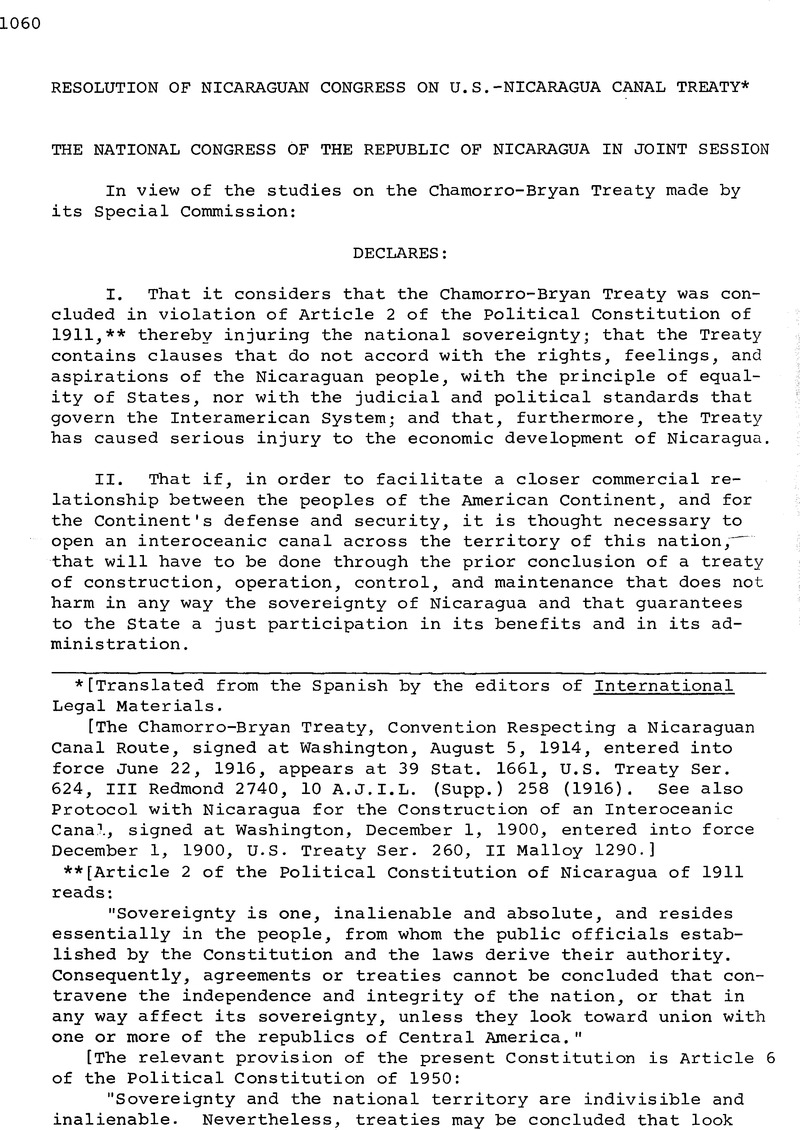No CrossRef data available.
Article contents
Resolution of Nicaraguan Congress on U.S.-Nicaragua Canal Treaty*
Published online by Cambridge University Press: 18 May 2017
Abstract

- Type
- Legislation and Regulations
- Information
- Copyright
- Copyright © American Society of International Law 1964
Footnotes
[Translated from the Spanish by the editors of International Legal Materials.
[The Chamorro-Bryan Treaty, Convention Respecting a Nicaraguan Canal Route, signed at Washington, August 5, 1914, entered into force June 22, 1916, appears at 39 Stat. 1661, U.S. Treaty Ser. 624, III Redmond 2740, 10 A.J.I.L. (Supp.) 258 (1916). See also Protocol with Nicaragua for the Construction of an Interoceanic Canal, signed at Washington, December 1, 1900, entered into force December 1, 1900, U.S. Treaty Ser. 260, II Malloy 1290.]
References
** [Article 2 of the Political Constitution of Nicaragua of 1911 reads:
“Sovereignty is one, inalienable and absolute, and resides essentially in the people, from whom the public officials established by the Constitution and the laws derive their authority. Consequently, agreements or treaties cannot be concluded that contravene the independence and integrity of the nation, or that in any way affect its sovereignty, unless they look toward union with one or more of the republics of Central America.”
[The relevant provision of the present Constitution is Article 6 of the Political Constitution of 1950:
“Sovereignty and the national territory are indivisible and inalienable. Nevertheless, treaties may be concluded that look toward union with one or several republics of Central America, or that have for their object the construction, improvement, operation and defense of an interoceanic canal across the national territory.
“Agreements may also be entered into that permit an American power to use temporarily part of the national territory, exclusively for continental defense. In any case, such use shall be restricted to the time absolutely necessary.”]
* [The press officer of the U.S. Department of State, on October 8, 1964, made the following statement on behalf of the Department:
“The Bryan-Chamorro Treaty of 1914 grants the United States what in/essence is an option for the construction of a canal; and the Treaty provides that, before construction could take place, the governments of Nicaragua and the United States would have to reach some mutually satisfactory agreement concerning the actual terms of the construction and the eventual operation and maintenance of the canal. It should also be made clear that the United States has never claimed and does not now claim ’sovereignty’ with respect to any part of Nicaraguan territory by virtue of the Bryan- Chamorro Treaty or otherwise. It is our understanding that the joint resolution passed October 6 by the Nicaraguan Congress does not constitute a ’repudiation’ of the Treaty, as was mentioned in some press stories, but calls for a new agreement to govern the terms of construction when and if it is decided to construct a canal in Nicaragua, as indeed the present Treaty provides.”]


